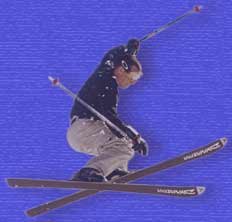| Freestyle Explained | Home Freestyle Terminology Freestyle History Freestlyle In The Olympics |
| So what is Freestyle? Freestyle applied to skiing covers the events of Moguls, Acro, Aerials, Big Air, Half Pipe and Ski across. All are FIS (Federation de Institute Ski) disciplines except for Acro and Big air. Moguls and Aerials are featured in the winter Olympics. Moguls - stonkingly fast runs down hideously steep pistes with two jumps in between. Most bump skiers now spin off the jumps to gain maximum marks, which means they can't see their landing for half of the time.
Acro - Tricks and spins on the flat to music. Judged on difficulty and artistry. Aerials - inverted jumps that are scary beyond belief. You just cannot get the idea of how big and clever this until you stand underneath one of the ten foot near vertical ramps they use to take off. Fortunately can be trained over water in Sheffield Ski centre- but it can still hurt if you land on your back in water from 20 ft up. Combinations of double and triple twisting somersaults and more. Big Air - find a big jump and hurl yourself off it. Flat spins, misty flips, 1080-degree rotations anything goes including landing backwards. Again judged on difficulty and style. Uses twin tip skis that are also generally excellent for all mountains playing. Halfpipe - skateboarding comes to skiing. 100 m of bliss with jump after jump of sheer joy off of the lip. Again upright, invert and fakie (backwards). You've guessed it - judged on difficulty and style. Ski-across - more downhill than Freestyle. Four or more skiers start at the top of a course that owes more to a bob sleigh run than piste. Whoever stays in the course and gets to the bottom first wins. Did I mention the occasional mammoth jump just to put you off? |
 |
| Home Freestyle | Top |
Freestyle History The three original disciplines of Freestyle (Acro, Moguls & Aerials) grew out of hot-dogging; a single run would include bump skiing, aerials and Acro tricks. The first competition took place in 1971 in the USA, sponsored by K2. Awards were given for fastest run, most unique etc. Unfortunately as the awards given rose in value, the competitors tried more and more varied and dangerous manoeuvres. After a spate of injuries, including a broken back the competition was broken up into three component parts - the modern three disciplines of Freestyle skiing. From that moment on inverted aerials were no longer allowed in moguls skiing. Mogul skiing became a fast success drawing huge crowds, most coming to join the party atmosphere, and watch the big crashes. The draw of big crowds and media interest did not go un-noticed by the International Ski Federation (now know as FIS), who in 1980, decided to bring it under their wing, and start the Freestyle World Cup Circuit. In 1986 the first freestyle World Championships were held in Tigne France. This proved to be a big hit, Europe went into a freestyle frenzy, and even Ski Sunday, who traditionally only covered alpine racing dedicating a whole show to the competition. |
|
| Freestyle In The Olympics
It seemed that mogul skiing was bound for Olympic competition, when in 1988 moguls were featured in Calgary as an Olympic demonstration sport. Sure enough in 1992 at the Alberville Olympics Edgar Grospiron won the first ever Gold medal in mogul skiing in front of a record crowd. Media coverage of mogul skiing has become increasingly impressive worldwide. At the 1994 Olympic Games in Lillehamer close to two billion viewers watched the event, with ten million Britons watching the BBC coverage. In 1998 Nagano Japan, tickets to the Mogul event were so much in demand that only the ice hockey final was more subscribed! Already for the 2002 Olympics in Salt Lake City USA it is reported that the Mogul event is sold out. Mogul skiing will always be one of the most watched Olympic sports. I believe that the key to its popularity is that both the skiing and non-skiing public can relate to what a feat it is just to get to the bottom of the slope. If mogul skiing were a Hollywood movie, it would be an action packed, emotional, roller-coaster ride of thrills and spills, featuring death defying stunts and some pretty neat special effects. |
|
| Home Freestyle | Top |